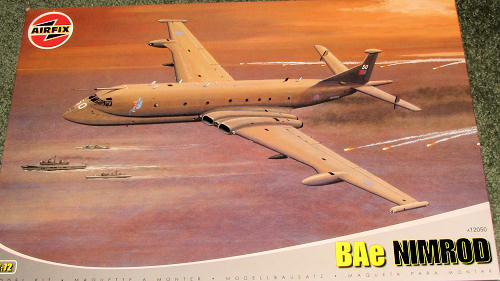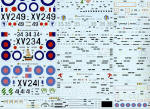
| KIT: | Airfix 1/72 Nimrod |
| KIT #: | 12050 |
| PRICE: | $53.55 from www.greatmodels.com |
| DECALS: | Six options (actually a few more) |
| REVIEWER: | Scott Van Aken |
| NOTES: | Brand new mold and a very large aircraft. |

| HISTORY |
The Nimrod is a maritime patrol aircraft developed in the United Kingdom. It is an extensive modification of the de Havilland Comet, the world's first jet airliner. It was originally designed by de Havilland's successor, Hawker Siddeley, now part of BAE Systems. A major modification was the fit of a large weapon bay under the fuselage that can carry and drop torpedoes, mines, bombs and other stores. Sonobuoys for tracking submarines are dropped from special launchers in the rear of the fuselage.
It has been the Royal Air Force's primary Maritime Patrol Aircraft (MPA) since the early 1970s, when it replaced the piston-engined Avro Shackleton. The RAF uses two Nimrod variants: the MR2 variant in the Maritime and Reconnaissance role; the R1 variant in a reconnaissance and electronic intelligence gathering capacity (ELINT).
The Nimrod was the first jet-powered MPA of any significance. Earlier MPA designs used piston or turboprop engines to improve fuel economy and allow for lengthy patrols. Jet engines are most economical at high altitudes and less economical at low altitudes. However, the transit to the operational area can be made at high altitude and in a jet aircraft this is not only economical on fuel but fast as well, compared to earlier piston-powered aircraft. After transit, the Nimrod descends to its patrol area.
That, in a nutshell, is the basic history of the Nimrod. It is currently being modified to MR.4 standards which upgrades everything on the airframe, including new engines and all new electronics. Pretty much a new plane without building a new plane. Even some of the still-borne AEW airframes have been used for this conversion, showing that the design is quite sound. The designers in the 50s had the foresight to produce an aircraft with the ability to allow it to grow when newer and better equipment came about.
Five aircraft have been lost in accidents (the most recent in September of 2006) and the original six squadrons operating the type are now down to four. Three squadrons (42[R], 120 and 201) from the Kinloss wing and there is 51 Sq, an ELINT unit with their three aircraft. 203 and 206 squadrons have been disbanded.
The Nimrod is currently in its third major camouflage scheme of greys. Previously it was in Hemp and Light Grey and before that, Light Grey and White. This kit allows any of these camouflage schemes to be done.
| THE KIT |
The Nimrod is one of those kits that has been long requested, but little has been done over the years. The only kit of any scale I'm aware of is the old Formaplane kit, a vacuform kit that has been bringing some pretty incredible prices on the various auction sites.
The demise of Airfix last year brought cries of anguish from modelers as the Nimrod was the next one to be brought forth. Fortunately, the new owners, Hornsby, have continued with the program and we now have what is a superlative kit of this very large aircraft. If you wish to see sprue shots, I foundthese while searching the web.
It would be safe to say that this is one of the best looking molds that Airfix has done. Some will say it is Hasegawa quality in the way the panel lines and other details are done and I'd have to say it is darn close. I'm sure there are detractors, but I'm not one of them. The kit has a reasonably complete cockpit with decals for instruments. The detailing is somewhat basic, but really, little can be seen. Of course, there are crew members.
As the kit has a full bomb bay, there is a fine representation of the curved pressurized cabin floor that helps to strengthen the very long fuselage. Rudder, elevators, and flaps are separate pieces, though neither are designed to be positioned in anything but the neutral position. There is a lot of room in the nose for the required weight as without it, it will be a tail-sitter.
The kit provides a plethora of weapons to put in the bomb bay, including mines, torpedoes and what looks like an auxiliary fuel tank system. Those who don't want to display all this stuff don't have to as there is a full, closed bay door option. Depending on the variant you are building, you'll want to stick on the wing tip pods, refueling probe, Sidewinder or Shrike missiles, Chaff pod and two sizes of strakes for the horizontal stabs. Probably the only complaint I have is about these stabs as Airfix has already opened the holes for these strakes, requiring filling to do the earlier variants. I also found it interesting that the aft cabin doors are separate pieces. Somewhat of a throwback to their earlier airliner kits as I seriously doubt anyone will build their kit with these doors open.
The instructions are excellent and most complete. There are separate final build sections depending on which of the six options you are going to choose. Each one has a different antenna suite and other differences somewhat unique to those versions. This is followed by a very detailed decal data placement guide, again, one for each of the six planes. This sheet is very well printed, though some may find the decals thicker than what they are used to.
 The decal sheet is huge, as much to the vast number of data markings as anything else. These are in different colors depending on which camo scheme you are using. As you can see, it would not all fit on the platen of my scanner. A nice touch is that there is a large, full color painting guide that shows the proper placement of all the large decals. Helps keep these from disappearing in the background of the data placement drawings.
The decal sheet is huge, as much to the vast number of data markings as anything else. These are in different colors depending on which camo scheme you are using. As you can see, it would not all fit on the platen of my scanner. A nice touch is that there is a large, full color painting guide that shows the proper placement of all the large decals. Helps keep these from disappearing in the background of the data placement drawings.
The six schemes are:
1. 203 Sq, MR.1, 1977, white and light grey camo
2. 201 Sq, MR.2P,1982, Falklands War, Hemp and grey
3. 201 Sq, MR.2 1988, Fincastle Trophy, Hemp and Grey with large lo-viz insignia
4. 42(R) Sq, MR.2P, 2003, Saudi Arabia, Hemp and Grey with small lo-viz insignia
5. Line Squadron, MR.2P, 2007, Greys
6. 51 Sq, R.1P, 2007, Greys. This one could also be done in Hemp and Grey if one wishes. The photo below (from 1989) shows one of these planes in this earlier scheme.

| CONCLUSIONS |
I'm sure that you have all read the reviews on other sites. As usual, I don't read the other guys so am not influenced by their opinions on things. It is not important to be first, just to give you another assessment that you can use when it comes time to make a purchase. I do know that it is a 'Limited Edition' release and already out of stock on the Airfix web site.
The kit is not inexpensive, but considering what you get, it is a reasonable price. I'm sure it will end up in the stash of many modelers who like big kits, but build few. It would be a shame not to tackle this one as it really is a beauty and I know you will not be disappointed.
| REFERENCES |
April 2008 If you would like your product reviewed fairly and fairly quickly, please contact the editor or see other details in the Note to Contributors.